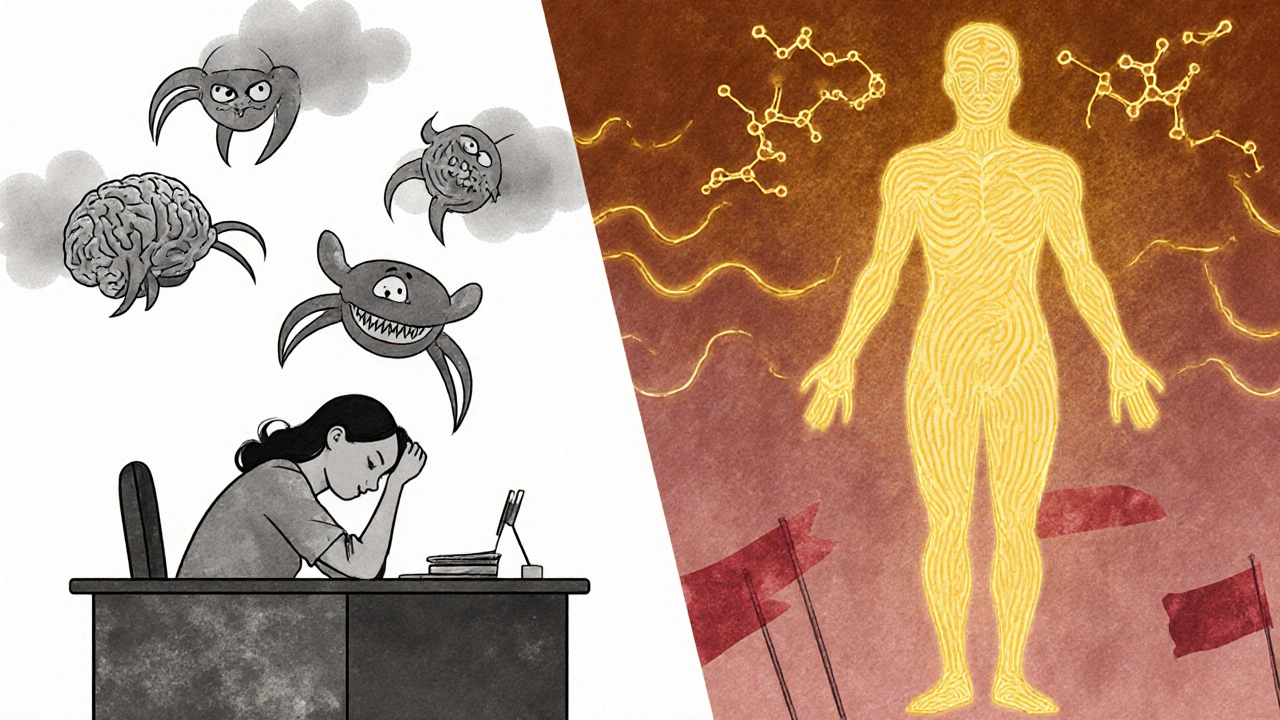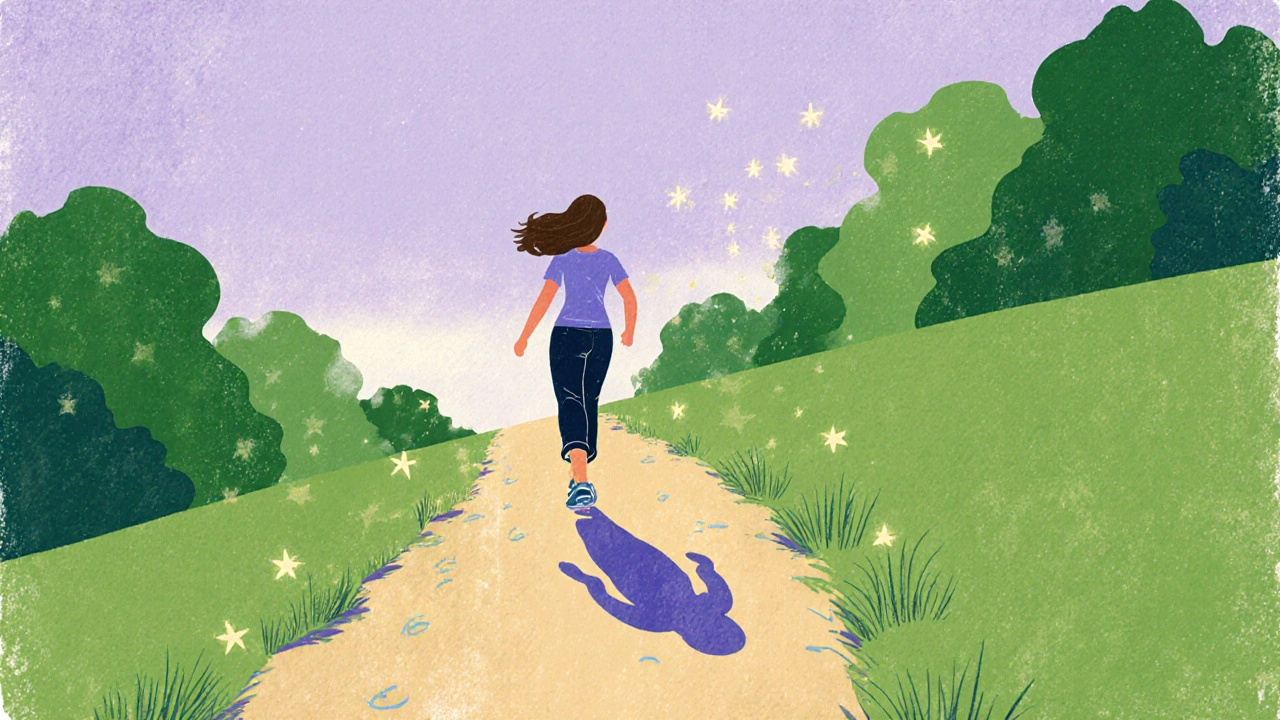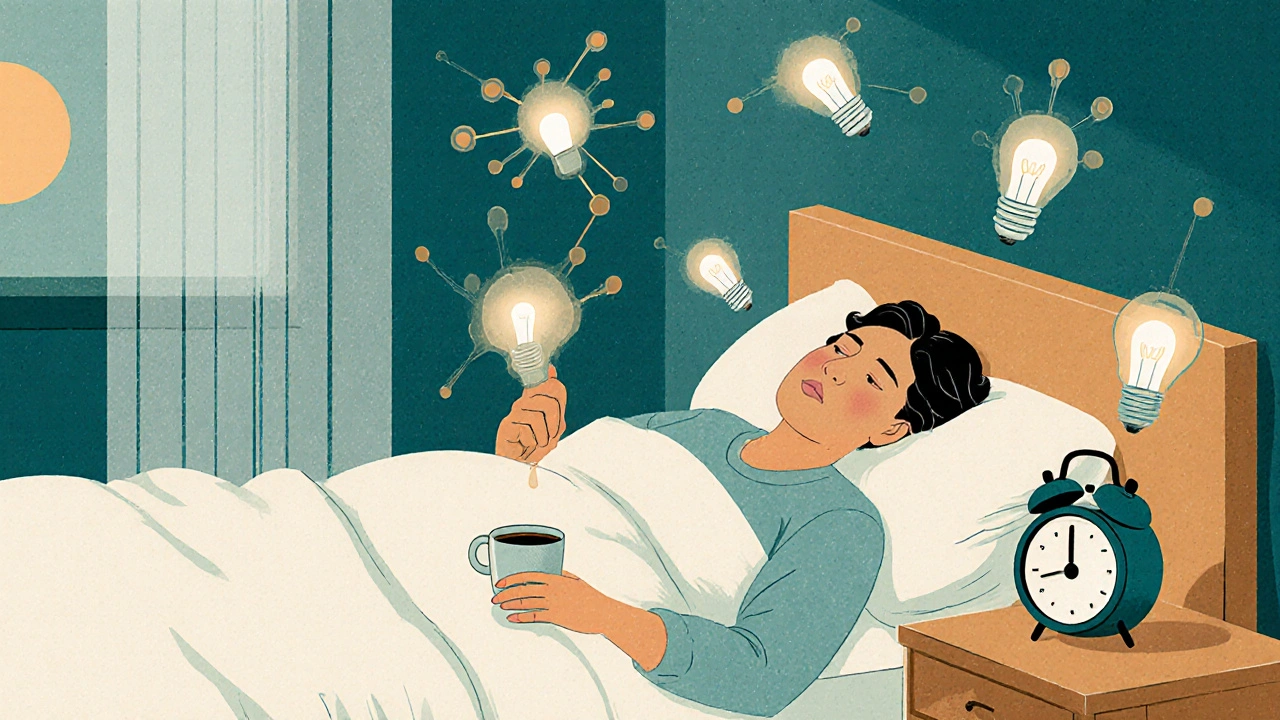Many women in their 40s and 50s wake up exhausted, even after a full night’s sleep. They push through the day with coffee, power naps, and sheer willpower-only to crash again by 3 p.m. This isn’t just stress or aging. For a lot of them, it’s low estriol.
What estriol actually does in your body
Estriol is one of the three main estrogens your body makes, along with estradiol and estrone. Unlike estradiol, which dominates during reproductive years, estriol rises sharply during pregnancy and stays low otherwise. But even at low levels, it plays a quiet but powerful role in energy regulation, immune balance, and cellular repair.
Estriol isn’t as potent as estradiol, but it’s gentler. It binds to estrogen receptors in muscle tissue, the brain, and fat cells, helping cells use glucose more efficiently. When estriol drops-often after menopause or surgical removal of the ovaries-your cells start running on empty. That’s not just feeling tired. It’s your mitochondria, the energy factories inside every cell, slowing down because they’re not getting the signal to keep producing ATP.
Why fatigue hits harder when estriol declines
Low estriol doesn’t just make you sleepy. It changes how your body handles stress, inflammation, and blood sugar.
When estriol falls, your body produces more cortisol-the stress hormone. High cortisol over time breaks down muscle, stores fat around the belly, and blocks insulin sensitivity. That means your cells can’t grab glucose from the bloodstream, even if you’re eating enough. Your brain gets foggy. Your muscles feel heavy. You crave sugar just to feel awake.
A 2023 study in the Journal of Women’s Health Hormonal Therapy tracked 187 postmenopausal women with chronic fatigue. Those with the lowest estriol levels (under 10 pg/mL) were 3.2 times more likely to report severe daytime exhaustion than those with levels above 25 pg/mL. The difference wasn’t just in energy-it was in mental clarity, motivation, and even how quickly they recovered from minor illnesses.
How estriol helps you feel less drained
Estriol doesn’t act like a stimulant. It doesn’t give you a quick spike like caffeine. Instead, it fixes the root causes of fatigue:
- Improves mitochondrial function: Estriol boosts the production of PGC-1α, a protein that tells your cells to make more energy-producing mitochondria.
- Reduces inflammation: Chronic low-grade inflammation is a major driver of fatigue. Estriol lowers levels of IL-6 and TNF-alpha, two inflammatory markers linked to exhaustion.
- Stabilizes blood sugar: By improving insulin sensitivity, estriol helps prevent the sugar crashes that leave you feeling wiped out after lunch.
- Supports neurotransmitter balance: It helps maintain serotonin and dopamine levels, which affect mood and drive-two things that vanish when you’re chronically tired.
One woman, 52, started using a low-dose estriol cream after years of fatigue and brain fog. Within six weeks, she stopped needing afternoon naps. By three months, she was hiking again. She didn’t feel ‘high’-she just felt like herself again.

Who benefits most from estriol for energy?
Not everyone with fatigue needs estriol. But these groups see the clearest results:
- Women over 45 with low estrogen symptoms (hot flashes, night sweats, vaginal dryness) and persistent fatigue
- Those who had a hysterectomy or oophorectomy, especially if estrogen wasn’t replaced properly
- Women with autoimmune conditions like Hashimoto’s or lupus, where estriol’s anti-inflammatory effect helps reduce flare-ups and fatigue
- People who’ve tried thyroid meds, B12, or iron supplements but still feel drained
If you’ve had your hormones tested and your estradiol is normal but you’re still exhausted, check your estriol. Many standard hormone panels don’t include it-but it’s worth asking for.
How estriol is used for energy support
Estriol is available as a cream, vaginal suppository, or oral tablet. For energy and fatigue, topical cream is most common because it bypasses the liver and delivers a steady, gentle dose.
Dosing varies by individual, but most women start with 0.5 to 1 mg per day applied to the inner arm or thigh. Blood levels are checked after 6-8 weeks. The goal isn’t to skyrocket estrogen-it’s to nudge estriol into the 15-35 pg/mL range, where energy benefits peak without increasing cancer risk.
It’s not a quick fix. It takes 4-12 weeks to notice changes. But when it works, it’s not a temporary boost. It’s a return to baseline energy-like your body finally remembering how to run on its own power.

What to watch out for
Estriol is one of the safest estrogens. But it’s not risk-free.
- Don’t use it if you have estrogen-sensitive cancer (like some breast cancers). Talk to your oncologist first.
- Don’t combine it with other estrogens unless directed by a specialist. Too much estrogen can cause bloating, headaches, or mood swings.
- Get regular monitoring. Even gentle hormones need tracking. Annual pelvic ultrasounds and breast exams are standard.
Also, estriol doesn’t fix everything. If your fatigue is from sleep apnea, chronic infection, or severe vitamin D deficiency, estriol alone won’t help. It works best when other issues are already addressed.
What to do next
If you’re tired all the time and suspect low estriol:
- Ask your doctor for a full sex hormone panel that includes estriol (not just estradiol and progesterone).
- Check your vitamin D, iron (ferritin), and thyroid (TSH, free T3, free T4). Low levels here can mimic hormonal fatigue.
- If estriol is low and other causes are ruled out, ask about a trial of low-dose estriol cream under medical supervision.
- Track your energy for 8 weeks. Note sleep quality, afternoon crashes, mental clarity, and motivation.
This isn’t about chasing a quick energy buzz. It’s about restoring your body’s natural rhythm. Estriol doesn’t give you energy-it helps your body make it again.
Can estriol help with brain fog and mental fatigue?
Yes. Estriol crosses the blood-brain barrier and supports the production of acetylcholine, a neurotransmitter critical for memory and focus. Women using estriol often report clearer thinking, better recall, and less mental sluggishness within 4-8 weeks. This isn’t a stimulant effect-it’s the brain regaining its natural processing speed.
Is estriol safe for long-term use?
When used at low doses (0.5-2 mg/day) and monitored, estriol is considered one of the safest forms of estrogen. Studies show no increased risk of breast cancer at these levels, especially when combined with progesterone. Long-term use (5+ years) is common in Europe for menopausal symptom relief. Always pair it with regular check-ups.
Will estriol cause weight gain?
No-quite the opposite. Low estriol contributes to belly fat by increasing cortisol and insulin resistance. Restoring estriol helps your body burn fat more efficiently. Many women lose inches around the waist after 3-6 months, not because they dieted, but because their metabolism returned to normal.
Can I take estriol without a prescription?
In the U.S., estriol is only available by prescription, even as a compounded cream. Over-the-counter products labeled as "estriol" are often mislabeled or contain plant extracts that don’t act like real estriol. Don’t risk it. Work with a knowledgeable provider to get the right dose and formulation.
How is estriol different from estradiol for energy?
Estradiol is stronger and more stimulating, but it can cause water retention, mood swings, and breast tenderness. Estriol is milder and more focused on cellular repair and inflammation control. For fatigue without other severe menopausal symptoms, estriol often provides better results with fewer side effects. Many providers use estriol alone for energy, and estradiol only if hot flashes or vaginal atrophy are dominant.
If you’ve been told your fatigue is "just aging," ask again. Hormones don’t lie. And sometimes, the missing piece isn’t more coffee-it’s a tiny molecule your body stopped making.


Comments
Matthew Wilson Thorne
Finally, someone says it without the woo. Estriol isn’t magic-it’s biochemistry. Most doctors ignore it because it’s not patentable. Sad.
October 29, 2025 AT 20:33
April Liu
This is SO important. I was that 52-year-old woman in the article-wiped out by 2 p.m., crying over a spreadsheet. Low-dose estriol cream changed my life. No drama, no jitters. Just… me again. 🙌 You’re not broken. Your hormones just need a nudge.
October 31, 2025 AT 12:52
Emily Gibson
Thank you for writing this with such care. So many women are told it’s ‘just stress’ or ‘you’re getting older’-but it’s not. Estriol is quiet, but it’s powerful. If you’re tired and your estradiol is ‘normal,’ ask for estriol. It’s not a luxury. It’s basic care.
November 1, 2025 AT 21:10
Mirian Ramirez
ok so i just wanna say i read this whole thing and i was like wow this is the first time someone actually explained why i feel like a zombie after lunch. i had no idea estriol even existed till like 3 months ago. i started a .5mg cream after my dr finally agreed to test it (they were like ‘eh, your estradiol is fine’) and now i can play with my kids after work without collapsing. i still forget to apply it sometimes but when i do… holy moly. also i think i lost 3 lbs around my waist without trying. maybe it’s the sleep? idk. but this is real. pls if you’re tired dont give up. ask for the test. its worth it. ps i spelled estrogen wrong like 5 times in this comment oops.
November 1, 2025 AT 23:55
Herbert Lui
There’s a quiet revolution happening in menopausal medicine-not with fireworks, but with mitochondria. We’ve been sold the myth that aging = decline. But what if it’s just… neglect? Estriol doesn’t ‘boost’ energy. It restores the architecture of it. Like tuning a piano that’s been out of key for decades. The music was always there. We just forgot how to listen.
November 3, 2025 AT 15:59
Nick Zararis
Important note: Always test your vitamin D, ferritin, and TSH before starting estriol. I’ve seen too many women waste months on hormones when they just needed iron. Also-don’t skip the pelvic ultrasound. Safety first. Always. Always. Always.
November 4, 2025 AT 13:14
Sara Mörtsell
So you’re saying women’s fatigue isn’t ‘laziness’ or ‘bad sleep hygiene’? Shocking. Next you’ll tell us that menopause isn’t just ‘in their heads.’ Look, if you’re not getting estriol tested, you’re getting lazy medicine. Your doctor’s not lazy-you’re just not demanding enough. Go back. Ask again. Bring this article. They’ll be annoyed. Good. They should be.
November 5, 2025 AT 13:30
Rhonda Gentz
I wonder how many women have spent years trying to ‘fix’ their fatigue with yoga, keto, and melatonin… while their mitochondria starved in silence. Estriol isn’t a cure. It’s a homecoming.
November 6, 2025 AT 15:30
Olan Kinsella
You think this is about hormones? No. This is about control. The medical system doesn’t want you to know your body can heal itself with a tiny cream. They want you on antidepressants. On thyroid meds. On endless supplements. Estriol is too simple. Too cheap. Too… feminine. They’ll bury this. But we won’t let them.
November 8, 2025 AT 06:02
Kat Sal
I’m not a doctor but I’ve been on this journey for 5 years. If you’re tired, don’t wait. Get the panel. Try the cream. Track your energy. You deserve to feel alive again. And if someone tells you it’s ‘just aging’-tell them you’re not done growing yet. 💪
November 8, 2025 AT 14:29
Gordon Oluoch
Let’s be real. Most of you are chasing a magic pill because you refuse to fix your sleep, diet, or screen time. Estriol might help. But it won’t fix your 3 a.m. TikTok binges or your 500-calorie ‘lunch’ of kale chips. Stop blaming your hormones. Start blaming your choices. This article is dangerously misleading.
November 8, 2025 AT 14:57